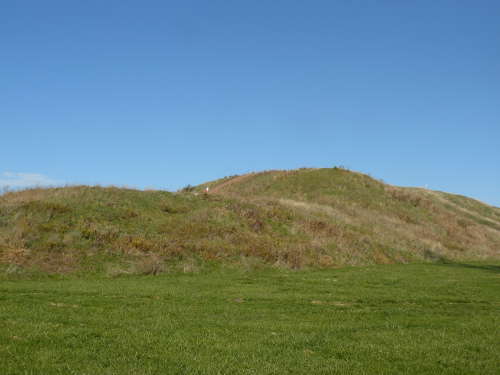 Location Taken: Cahokia Mounds State Park, Collinsville, Illinois
Location Taken: Cahokia Mounds State Park, Collinsville, Illinois
Time Taken: November 2012
Behold! The grand city of Cahokia!
This grand temple was once the center of the largest city in the world, the cultural hub of the continent! The people who lived here traded up and down the Mississippi River, bringing together copper from the north and shells from the south to create fabulous pieces of art!
And, well, today it’s a giant mound of dirt used primarily by joggers as a good source of stair exercise. You can see a few of them in this photo, those little specks of orange and white at the notch in the mound. Which isn’t a notch, really, just angles making a lower terrace look like one. But that should at least give you a sense of scale. This is a really really big mound of dirt. About 100 feet tall, 951 feet long, and 836 feet wide, and made entirely by people. This really required a massive amount of manpower and effort to construct, back in the days before heavy machinery.
There’s mounds scattered all around this large one, though they really are just lumps of dirt on an otherwise flat region. You could make the place into a golf course and you wouldn’t realize these were anything special. For an impressive feat of cultural achievement, the city didn’t leave much behind. It took a lot of archeological work for people to realize what this cluster of mounds actually was, and by that point a significant amount of the outlying mounds were removed due to the growing suburbs of St. Louis, just seven miles away. I guess both the ancient peoples and the modern ones knew a good spot for a city when they saw one.
There’s evidence that the city covered some six square miles of land, about a tenth of the size of modern day St. Louis. But even then, the prevalent theory is that the city died because it succeeded too well. In the days before modern transportation, refrigeration, and agriculture, growing enough food for a city and getting it to the people before it rotted was a monumental task. At some point, you just wouldn’t be able to feed everyone properly, and the excess would leave. As would some of the other people, following the trend, and so on. All the local natural resources slowly ran out, and eventually everyone decided to find more prosperous lands elsewhere.
There’s not much left of the place now, despite it being abandoned for only about 500 years, about as long as the much better preserved Machu Picchu. I guess it shows if you really want your culture to be well known long after you’re gone, build with something other than wood and dirt. Sure, it might be great for the environment, but wood rots and dirt erodes! It’s the fancy stone places that get all the tourist bucks these days, since most tourists don’t want to use their imaginations to the extent needed to see Cahokia these days. The city was grand and vast, but it’s just piles of dirt these days.
